CURIOUS FACTS ABOUT SEXTON BLAKE
by Mark Hodder
The Clue of the Iconic Cover
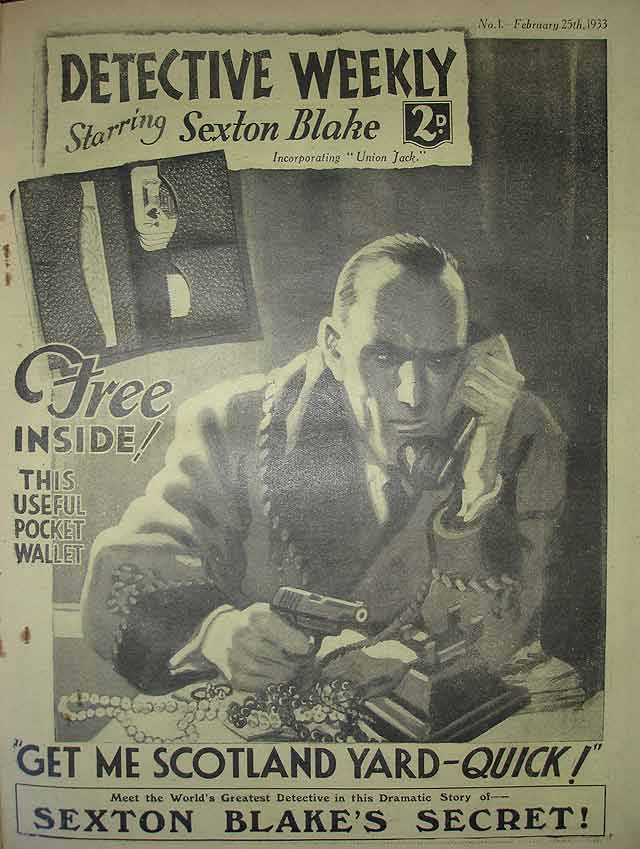 One of the most striking cover illustrations to ever appear in the Sexton Blake saga was that which decorated the first issue of DETECTIVE WEEKLY, published in 1933. Drawn by the ultimate Blake artist, Eric Parker, it shows the tensed-for-action, dressing-gown-clad detective clutching a pistol and a telephone, demanding "GET ME SCOTLAND YARD — QUICK!"
One of the most striking cover illustrations to ever appear in the Sexton Blake saga was that which decorated the first issue of DETECTIVE WEEKLY, published in 1933. Drawn by the ultimate Blake artist, Eric Parker, it shows the tensed-for-action, dressing-gown-clad detective clutching a pistol and a telephone, demanding "GET ME SCOTLAND YARD — QUICK!"
Seven years later, Parker produced a colour version for the second Sexton Blake Annual. This time, the picture was in glorious colour and Tinker and Pedro were added to the composition, looking eagerly over the detective's shoulder.
But guess what? Eric Parker wasn't the originator of this image! It was based on a version by an uncredited artist that adorned the cover of PENNY PICTORIAL issue 429 way back in 1907. That picture shows a much younger Sexton Blake (with a very full head of hair!) thoughtfully holding his chin in one hand and an old-fashioned telephone in the other. There's a very slight change in the wording — "Put me on to Scotland Yard QUICK!!" — but the sentiment is exactly the same.
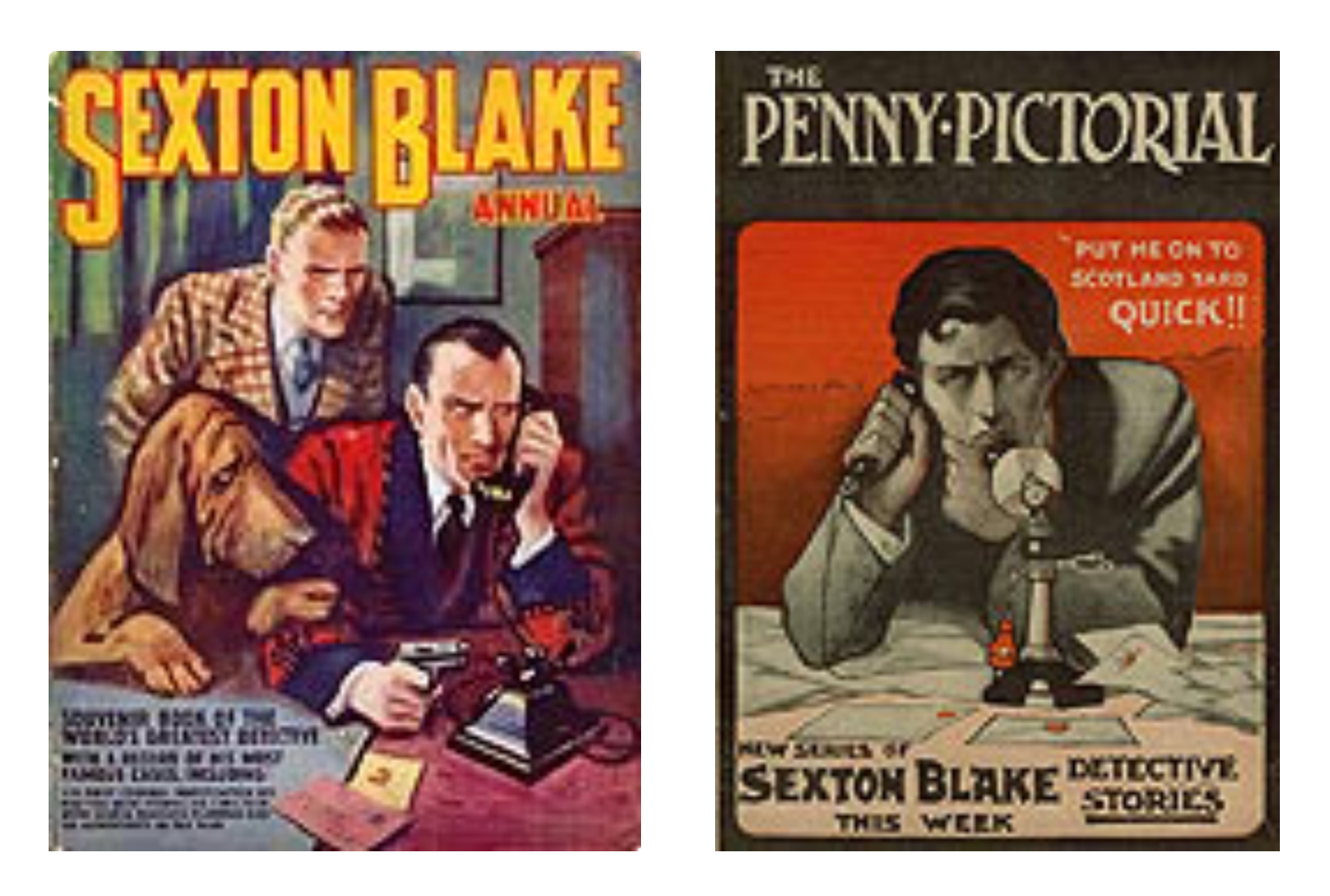
The Incident of the Unlawful Investigator
Sexton Blake was a law-breaking tattooist!
He certainly had a passion for justice but Sexton Blake most definitely did not have much regard for the laws of the land despite being a qualified lawyer. On literally thousands of occasions he removed, concealed and withheld essential police evidence from crime scenes. No wonder he was always one step ahead of the boys in blue!
One of Blake's worst examples of 'independent justice' occurs during his first appearance in the new series of UNION JACK. In 1904's SEXTON BLAKE'S TRIUMPH, the detective carries with him a small tool with which, after rendering villains unconscious, he tattoos upon their foreheads a broad yellow arrow, marking them as criminals for life. Okay, maybe they deserve it ... but bear in mind that these guys haven't even been charged with a crime, let alone convicted!
The Mystery of Tight-Lipped Tinker
Sexton Blake's assistant, Tinker, was a ventriloquist's dummy!
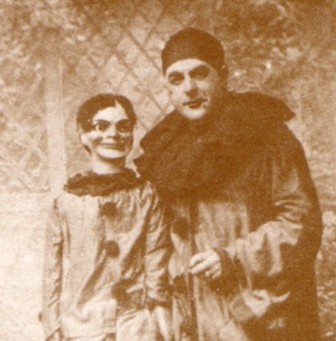 In THE PENNY PICTORIAL issue 527 published in 1909, a short article reveals that 'al fresco entertainer' Mr. Reuben More employed an effigy of Sexton Blake's assistant for his ventriloquist act:
In THE PENNY PICTORIAL issue 527 published in 1909, a short article reveals that 'al fresco entertainer' Mr. Reuben More employed an effigy of Sexton Blake's assistant for his ventriloquist act:
'Most of us admire originality, and we get it in large doses in Mr. Reuben More, the most versatile al fresco entertainer in the United Kingdom. Who was it gave a freshness to open-air entertainments by introducing a troupe of Black Pierrots? — Mr. Reuben More. Who was the first to realise that Tinker, the young assistant of Sexton Blake, Detective, would make a more popular character for a ventriloquist than any other ever heard of? — Mr. Reuben More. Tinker has appeared in over five hundred stories of Sexton Blake, and that is sufficient to explain why he is greeted rapturously as a very old friend wherever Mr. More presents him.'
The Curious Case of the Cockney Criminologist
Sexton Blake is cockney rhyming slang!
During the first half of the twentieth century Sexton Blake became so much a part of British culture that he entered the language ... well, the language of London's East End, anyway. A typical Cockney conversation might run something like this:
"Cor Blimey! That geezer's flashin' 'is Rolex abaaht like nobody's business. Don't 'e know it's a sexton?"
'Sexton' as in 'Sexton Blake' as in 'fake'.
This must have caused some truly worrying moments for any less-than-honest inhabitants of the area (and if the Blake stories are to be believed, the East End is absolutely teeming with criminals). Imagine this scenario: a villainous scoundrel is trying to sell some counterfeit coins to a dealer. The expert casts his discerning eye over them and exclaims "Sexton Blake!" The blood drains from the crook's face as he waits for the inevitable hand of justice to fall upon his shoulder and an incisive voice to declare "We've netted our fish, Tinker!"
There is some suggestion that the name of our favourite hero is also cockney rhyming slang for 'cake', though this seems unlikely as this item of confectionary has no connection with crime (unless you count the ones delivered to prisons with files baked into their middle).
The Secret of the Savage Assistant
One of Sexton Blake's pre-Tinker assistants was a bowler hat-wearing ape!
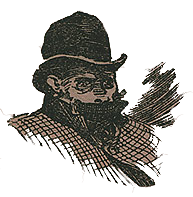 In UNION JACK's 18-part serial GRIFF THE MAN-TRACKER (1901), Blake's sidekick leaps from rooftop to rooftop, climbs walls and balances on the narrowest of ledges with absolute ease. Griff is short and broad, with bandy legs and long arms. He usually wears a coat, black gloves, blue-tinted goggles, a bowler hat and a scarf wrapped around his lower face. His 'at home' attire consists of a smoking-cap, long red dressing gown, baggy trousers and vermillion slippers. His eyes are 'fiery slits' and he communicates with Blake via barks, growls and whines.
In UNION JACK's 18-part serial GRIFF THE MAN-TRACKER (1901), Blake's sidekick leaps from rooftop to rooftop, climbs walls and balances on the narrowest of ledges with absolute ease. Griff is short and broad, with bandy legs and long arms. He usually wears a coat, black gloves, blue-tinted goggles, a bowler hat and a scarf wrapped around his lower face. His 'at home' attire consists of a smoking-cap, long red dressing gown, baggy trousers and vermillion slippers. His eyes are 'fiery slits' and he communicates with Blake via barks, growls and whines.
England is not Griff's natural environment and he has to breathe through a respirator to protect him from the damp air. Sexton Blake buys special fruit for his assistant's meals; something approximating the fruits of Griff's homeland (wherever that is). He has carefully trained this strange wild creature but even the greatest of all detectives can't cure Griff of an instinctive dislike of uniformed policemen.
Despite his heroics in the serial, Griff never appeared again and it must be assumed that Blake, probably in an act of kindness, took him back to whatever jungle he came from.
The Mysterious Matter of the Undesignated Detective
Sexton Blake is not his real name!
One of the most incredible statements ever made about Sexton Blake appears in SEXTON BLAKE AT SCHOOL part 1 (THE BOYS' HERALD issue 238). This story begins with our hero as an unnamed boy living in mysterious circumstances with his mentor, Dr. Lanchester. When the latter is murdered, the boy finds a letter which directs him to two of Lanchester's colleagues. As he waits to see them, they discuss him:
"There is one thing we have forgotten. As far as the world at large is concerned, up to the present he has no name, and the truth would be unsafe—impossible. We dare not let—"
"It is true, we had forgotten," interrupted the other. "He must certainly have a name." He tapped on the table thoughtfully with his amber holder. "We will call him Blake—Sexton Blake!"
"Capital!" exclaimed the other. "Sexton Blake; it gives a clue to the truth, yet conceals it."
The Adventure of the Accosting Author
The Blake writer who caught a criminal!
The newspapers gave big headlines to the part played by a famous Sexton Blake author in the capture of a convict who escaped from Dartmoor. Rex Hardinge, a prime favourite among the most outstanding Blake writers, had a writing hideaway at Bachelor's Hall, Princetown, about a mile from the prison. He was making tea in the kitchen when he spotted the clue: his breakfast ingredients had vanished.
"I know Sexton Blake would have done all sorts of marvellous things," said Mr. Hardinge, "but I just put on my coat and ran to the authorities. That's the best thing for anybody to do."
The police found the convict — an Italian — in a copse near the Sexton Blake author's cottage.
The Scandal of the Scurrilous Story
Sexton Blake author: murdered!
"A bigger bunch of villains than the ones they write about!" That's how UNION JACK Editor H. W. Twyman described the merry band of authors who, week in and week out, kept the public enthralled with their tales of the world's finest consulting detective.
They were a colourful lot: Cecil Hayter went bear shooting with Teddy Roosevelt; Rex Hardinge had travelled solo across Africa; H. H. Clifford Gibbons used the money earned from writing to build racing cars, which he raced himself; Stanley Gordon Shaw had been a trapper and lumberjack in Canada; Donald Stuart wrote his first Blake while living rough on the Embankment ...
With characters like that, it should come as no surprise to learn that there are quite a few stories doing the rounds about the Blake authors. Most concern the various tricks by which, with a pay cheque at stake, unfinished manuscripts were handed in disguised as the finished article.
However, by far the most salacious story concerns Ernest Sempill (aka Michael Storm) who mysteriously vanished from all records around 1909. Three years later, Sempill's widow (presumed widowed, at any rate) sailed to England from Australia in the company of a young man named George H. Teed. During the voyage, she encouraged him to write and, three years later, he had the first of many Sexton Blake tales published, making his debut as one of the greatest of all the Blake authors.
Rumours persisted, however, that Teed was somehow responsible for Sempill's disappearance ... whispers of "murder"! Maybe it was because Teed arrived in England in the widow's company. Or maybe it was something to do with the title of his first tale: DEAD MEN'S SHOES.
Teed died in 1939, taking the truth with him.
The Affair of the Familiar Face
Sexton Blake wasn't always quite himself!
 Is this Sexton Blake? Nope, its Victor Drago, who, with his teenage assistant Spencer and faithful bloodhound Brutus, was the scourge of ne'er-do-wells in 1920s Britain. Drago appeared in comic-strip format (plus a few illustrated stories) in TORNADO, which ran for 22 issues in 1979. He was, as is obvious, originally intended to be Sexton Blake. The evidence goes beyond the physical resemblance; Drago's Rolls Royce is named the Silver Lady ... but in a panel in one of the comics it's referred to as the Grey Panther, which, of course, is the name of Blake's Rolls. Even more telling, the car's number plate is SB 192!
Is this Sexton Blake? Nope, its Victor Drago, who, with his teenage assistant Spencer and faithful bloodhound Brutus, was the scourge of ne'er-do-wells in 1920s Britain. Drago appeared in comic-strip format (plus a few illustrated stories) in TORNADO, which ran for 22 issues in 1979. He was, as is obvious, originally intended to be Sexton Blake. The evidence goes beyond the physical resemblance; Drago's Rolls Royce is named the Silver Lady ... but in a panel in one of the comics it's referred to as the Grey Panther, which, of course, is the name of Blake's Rolls. Even more telling, the car's number plate is SB 192!
It's generally thought that the Editors had every intention of featuring Sexton Blake until a copyright issue arose — a hangover from Fleetway's dealings with ITV. Thus the first strip was doctored to remove all the Blakeian references, replacing them with Victor Drago and Co.
—
But Drago is by no means the only Sexton Blake doppelgänger. Back in the mid-1920s, THE BOYS' FRIEND ran a series of short stories featuring Harold Hood, his youthful ex-newsboy assistant, Billy Williams, and their clever bloodhound, Guardsman. They lived on Jermyn Street rather than Baker Street but in every other way appeared identical to Blake and Co. Maybe Blake our favourite detective was working under cover?
The Episode of the Editor's Evidence
Sexton Blake was real!
In THE HALFPENNY MARVEL issue 42 (25/08/1894), the editor has this to say:
It will interest readers of our detective stories to know that Sexton Blake—who, by the way, is a real live personage, and not a fictional character, as some may suppose—can, when he chooses, disguiso himself so completely as to baffle even his most intimate friends. Once he made a wager with an acquaintance that within
four days he would address him four times, and on each occasion converse with him for ten minutes, without being recognised. In the course of the next four days Sexton Blake presented himself in the character of a bootmaker's assistant, a hack-driver, an
elderly gentleman, and finally as a waiter in the hotel where the gentleman was staying, and on each of these occasions his friend failed to recognise him.
In THE BOYS' FRIEND, in 1906, a reader's letter asks whether Sherlock Holmes ever lived. The Editor replies by stating that Holmes wasn't real but was based on a celebrated 'Scotch' surgeon, Dr. Bell. He then goes on to claim that: 'The same explanation also applies to that celebrated detective, Sexton Blake; so that I may say, without revealing a secret, that he is a real living personality. He was also at one time attached to the Metropolitan Police detective department. He found, however, that his connection with a Government institution somewhat hampered him in his methods, and therefore he resigned from the force, and is now perhaps the leading private detective of the world; in fact, many of his adventures form the basis of the stories of SEXTON BLAKE which are published not only in THE BOYS' FRIEND, but weekly in the UNION JACK.'
So who was this mysterious man? We learn more a year later, when the same Editor writes:
'DOES SEXTON BLAKE EXIST? Almost every day I receive letters from my chums asking me this question. It serves to show the great enthusiasm which the great detective has aroused in the minds of the readers of our new serial, "Sexton Blake in the Congo," as well as of our weekly complete novels which appear in the UNION JACK. Well, then, the great detective does exist, and very much so, as members of the criminal profession know to their cost. He is occasionally to be seen in his office, the whereabouts of which I am not permitted to disclose, other than to say that it is situated less than five miles from Charing Cross. Another thing I am not permitted to state is his name, for obvious reasons, he does not practice professionally under the name of Sexton Blake.'
There are many other statements and hints sprinkled throughout the saga (especially in the earlier issues) which support the assertion that Sexton Blake was based on a real person.
The Adventure of the Dumpy Delinquent
Sexton Blake met Billy Bunter!
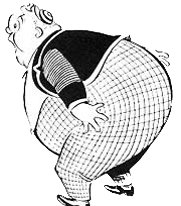 In MAGNET issue 818, Dick Russell, one of the poorer of the boys at Greyfriars School suddenly becomes wealthy when his father secures a job as secretary to a rather generous employer. But one day, his request for further funds receives no reply. Dick, with Harry Wharton and Co., visits his home only to find it swarming with police. It turns out that his father has vanished and is wanted for treason. The boys decide to commission Ferrers Locke to trace the missing man but when he proves unavailable, they engage Sexton Blake and Tinker.
In MAGNET issue 818, Dick Russell, one of the poorer of the boys at Greyfriars School suddenly becomes wealthy when his father secures a job as secretary to a rather generous employer. But one day, his request for further funds receives no reply. Dick, with Harry Wharton and Co., visits his home only to find it swarming with police. It turns out that his father has vanished and is wanted for treason. The boys decide to commission Ferrers Locke to trace the missing man but when he proves unavailable, they engage Sexton Blake and Tinker.
This is the one and only time that the Blake series and the Greyfriars series had a crossover story ... and a certain young man by name of Billy Bunter plays a crucial role in the investigation by accidentally providing the detective with the key to the mystery.
